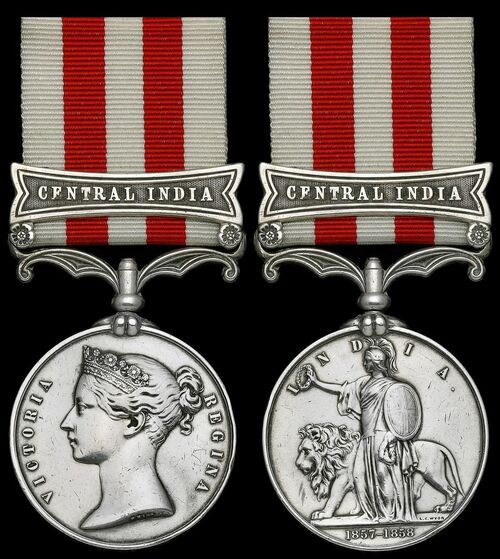
Auction: 23112 - Orders, Decorations and Medals - e-Auction
Lot: 73
An unusual 'Action at Kentee' casualty's Indian Mutiny Medal awarded to Bombardier A. Rickett, 'B' Company, 4th Battalion, Madras Artillery, who was wounded by a battle-axe during the action on 4 March 1859
Indian Mutiny 1857-59, 1 clasp, Central India (Bombr Anty. Rcikett [sic], B Cy. 4th Bn Madras Art.), contact wear and pitting, slight edge bruise, very fine
Anthony Rickett was born at Falkingham (now known as Folkingham), Lincolnshire in 1829 and enlisted with the armed forces of the Honourable East India Company at Liverpool on 2 August 1847. Embarking on H.M.S. Thetis and arriving at Madras in 1848, at the outbreak of the Indian Mutiny in 1857 Rickett was stationed with ‘B’ Company, 4th Battalion, Madras Artillery with the rank of Bombardier.
This unit was attached to the Saugor Field Division seeing action at Kubrae on 17 April before advancing to the Battle of Banda the two days later. This action pitted a column of 1,000 men under General Whitlock against a force of 7,000 mutineers under the Nawab of Banda. Victory at Banda allowed the column to advance on Kirwi; in this state the Madras Gunners were in action during the Defence of Kirwi Palace on 25 December and later in the week on 29 December.
Further action early the next year at Chicumba left 2nd Captain J. B. Swete of the Madras Horse Artillery severely wounded on 15 January 1859. From here they advanced to Kentee were a force of mutineers led by Lopal Singh ambushed the column, attacking both soldiers and civilians. Ricketts was wounded by a battle-axe during the engagement which ended with the mutineers withdrawing having caused heavy losses. They were pursued by 100 Sikh cavalrymen under Brigadier Faddy who exacted a heavy revenge on the attackers.
Ricketts survived his wound and remained with the unit for the rest of the Mutiny although he does not appear to have transferred to the Royal Artillery when the H.E.I.C. army disbanded in 1861. He did however remain in India, joining the European Veterans Establishment, an institution he remained with until his death on 14 April 1893. The burial register notes his death as caused by an ‘abscess of the liver’ and he was buried at Pallaveram cemetery by Major A. G. H. Hayne of the Veterans Establishment; sold together with a copied casualty roll, biography and medal rolls as well as a registry of the Veterans Establishment and burial details.
Subject to 20% VAT on Buyer’s Premium. For more information please view Terms and Conditions for Buyers.
Sold for
£380
Starting price
£140




